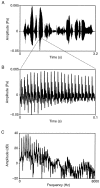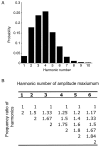The statistical structure of human speech sounds predicts musical universals
- PMID: 12904476
- PMCID: PMC6740660
- DOI: 10.1523/JNEUROSCI.23-18-07160.2003
The statistical structure of human speech sounds predicts musical universals
Abstract
The similarity of musical scales and consonance judgments across human populations has no generally accepted explanation. Here we present evidence that these aspects of auditory perception arise from the statistical structure of naturally occurring periodic sound stimuli. An analysis of speech sounds, the principal source of periodic sound stimuli in the human acoustical environment, shows that the probability distribution of amplitude-frequency combinations in human utterances predicts both the structure of the chromatic scale and consonance ordering. These observations suggest that what we hear is determined by the statistical relationship between acoustical stimuli and their naturally occurring sources, rather than by the physical parameters of the stimulus per se.
Figures







Similar articles
-
Musical intervals in speech.Proc Natl Acad Sci U S A. 2007 Jun 5;104(23):9852-7. doi: 10.1073/pnas.0703140104. Epub 2007 May 24. Proc Natl Acad Sci U S A. 2007. PMID: 17525146 Free PMC article.
-
YIN, a fundamental frequency estimator for speech and music.J Acoust Soc Am. 2002 Apr;111(4):1917-30. doi: 10.1121/1.1458024. J Acoust Soc Am. 2002. PMID: 12002874
-
Pitch is determined by naturally occurring periodic sounds.Hear Res. 2004 Aug;194(1-2):31-46. doi: 10.1016/j.heares.2004.01.019. Hear Res. 2004. PMID: 15276674
-
Neural sensitivity to statistical regularities as a fundamental biological process that underlies auditory learning: the role of musical practice.Hear Res. 2014 Feb;308:122-8. doi: 10.1016/j.heares.2013.08.018. Epub 2013 Sep 12. Hear Res. 2014. PMID: 24035820 Review.
-
Temporal modulations in speech and music.Neurosci Biobehav Rev. 2017 Oct;81(Pt B):181-187. doi: 10.1016/j.neubiorev.2017.02.011. Epub 2017 Feb 14. Neurosci Biobehav Rev. 2017. PMID: 28212857 Review.
Cited by
-
How a cognitive psychologist came to seek universal laws.Psychon Bull Rev. 2004 Feb;11(1):1-23. doi: 10.3758/bf03206455. Psychon Bull Rev. 2004. PMID: 15116981
-
Musical melody and speech intonation: singing a different tune.PLoS Biol. 2012;10(7):e1001372. doi: 10.1371/journal.pbio.1001372. Epub 2012 Jul 31. PLoS Biol. 2012. PMID: 22859909 Free PMC article.
-
Music and Language in Social Interaction: Synchrony, Antiphony, and Functional Origins.Front Psychol. 2019 Jul 2;10:1514. doi: 10.3389/fpsyg.2019.01514. eCollection 2019. Front Psychol. 2019. PMID: 31312163 Free PMC article.
-
The (Co)Evolution of Language and Music Under Human Self-Domestication.Hum Nat. 2023 Jun;34(2):229-275. doi: 10.1007/s12110-023-09447-1. Epub 2023 Apr 25. Hum Nat. 2023. PMID: 37097428 Free PMC article.
-
When sounds come alive: animacy in the auditory sense.Front Psychol. 2024 Oct 25;15:1498702. doi: 10.3389/fpsyg.2024.1498702. eCollection 2024. Front Psychol. 2024. PMID: 39526129 Free PMC article. Review.
References
-
- Balzano GJ ( 1980) The group-theoretic description of 12-fold and microtonal pitch systems. Comp Mus J 4: 66-84.
-
- Boersma P, Weenink D (2001) PRAAT 4.0.7: Doing phonetics by computer. (Department of Phonetic Sciences, University of Amsterdam). [There is no print version; download is available at http://fonsg3.let.uva.nl/praat/].
-
- Braun M ( 1999) Auditory midbrain laminar structure appears adapted to f0 extraction: further evidence and implications of the double critical bandwidth. Hear Res 129: 71-82. - PubMed
-
- Buch E ( 1900) Uber die Verschmelzungen von Empfindungen besonders bei klangeindrucken. Phil Stud 15: 240.
-
- Budge H ( 1943) A study of chord frequencies. New York: Bureau of Publications, Teachers College, Columbia University.
Publication types
MeSH terms
LinkOut - more resources
Full Text Sources
